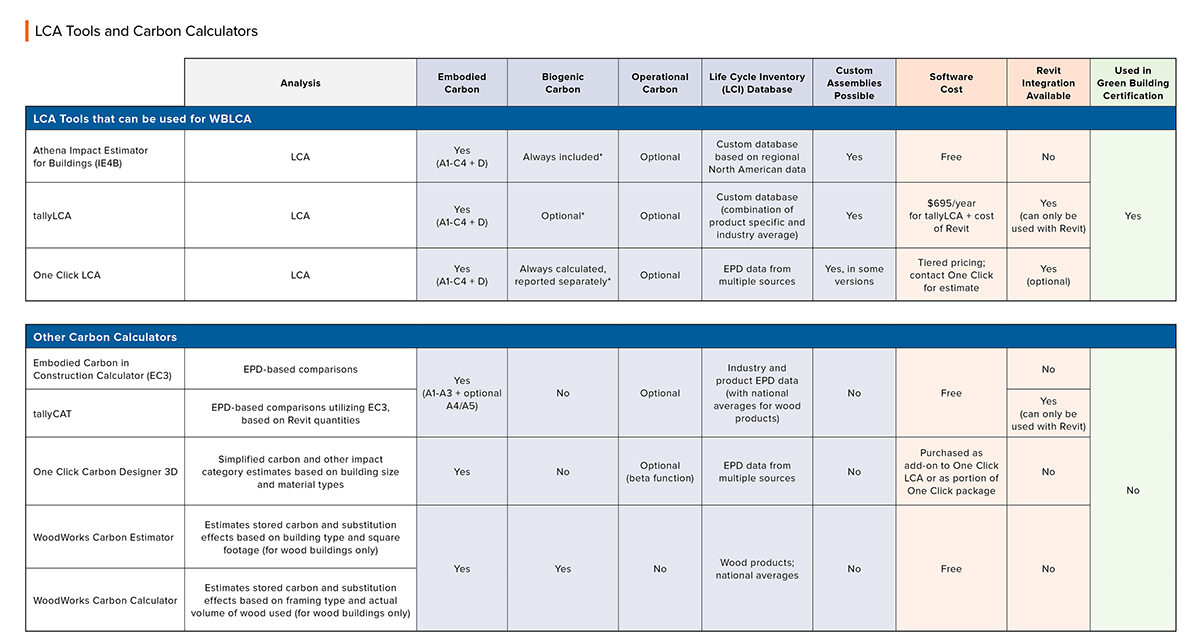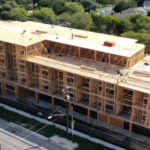Expert Tips
Carbon Accounting Tools for Structural Systems
An overview of whole building life cycle assessment tools and carbon calculators available to building designers

For more information on whole building life cycle assessment, biogenic carbon and carbon storage, and environmental product declarations, visit our Sustainability page. View a complete list of sustainability resources here.
It is generally understood that wood structures can have a significantly lower carbon impact than structures made from other materials, due to both lower embodied carbon and biogenic carbon storage.1 There are a variety of ways to demonstrate this by assessing the potential carbon impacts of new construction, renovation, or retrofits. Some methods are more complex, such as life cycle assessment (LCA), while others, such as carbon calculators, are simpler.
Life Cycle Assessment and LCA Tools
LCA is defined in ISO 14040 as the “compilation and evaluation of the inputs, outputs and the potential environmental impacts of a product system throughout its life cycle,” 2 and has emerged as the most scientifically rigorous way to quantify and compare the environmental impacts of buildings and/or building products over their lifetime.3 LCAs can be performed on individual products or assemblies, for example, to compare different insulation products or cladding systems, or applied to an entire building system. The latter is referred to as whole building life cycle assessment (WBLCA). A more detailed explanation of WBLCA, including a description of life cycle stages, system scope, and applicability of comparisons, can be found in the WoodWorks article, Introduction to Whole Building Life Cycle Assessment: The Basics.
LCA tools can be used to compile and evaluate the impacts of all the products that comprise a building—from raw material extraction, manufacturing, transportation, construction, building operation and maintenance, to end-of-life scenarios. Unlike the direct comparison of environmental product declarations (EPDs), the data used in LCA tools has been harmonized, meaning it’s been adjusted to ensure accurate comparisons. Due to the intricacies of selecting the right products and quantities, these tools are best used by someone familiar with the building’s design and material selections.
In North America, the three most common commercial WBLCA tools are Athena Impact Estimator for Buildings, tallyLCA, and One Click LCA.
- Athena Impact Estimator for Buildings (IE4B) is a stand-alone tool that uses Athena’s own life cycle inventory (LCI) database for regional U.S. and Canadian products.
- tallyLCA (commonly known as “Tally”) is a Revit software plug-in that also has a custom database, which includes a combination of product-specific and industry-averaged materials.
- One Click LCA is part of a suite of life cycle and carbon accounting products and utilizes EPDs from multiple databases, as well as their own generic materials database. It is capable of importing models from Revit, Tekla, and other software.
In addition to using different databases as the basis for calculation, another major distinction between the tools, specific to the evaluation of wood buildings, is that each treats biogenic carbon and end-of-life assumptions differently—which means the results will also vary. This is addressed in our article, Biogenic Carbon Accounting in WBLCA Tools.
Additional tools are available specific to other global regions, and rely on the standards, data, and practices applicable to those areas. Before utilizing any tool, designers should verify that the datasets and assumptions are appropriate for the location and materials of the project. Note that North American LCAs are typically based on ISO standards, while LCAs elsewhere may rely on other standards.
Other Carbon Assessment Tools
Carbon assessment tools also exist that rely on methodologies other than LCA. Many attempt to make comparisons between products, assemblies, or systems on the basis of cradle-to-gate data reported in EPDs. Although these tools are typically simpler to use than LCA tools, the results are also more limited because the input information may not span the building’s lifetime, may not result in an apples-to-apples comparison of different products, may not include biogenic carbon accounting, and can be based on data developed under different product category rules. The limitations of using EPD data to make a comparison are discussed in the article, How to Use Environmental Product Declarations.
Some of the more commonly used carbon comparison tools include the following:
- The Embodied Carbon in Construction Calculator (EC3) and tallyCAT (Climate Action Tool) are both available from Building Transparency, the same company that provides tallyLCA.
- EC3 is an EPD-based procurement tool intended to directly compare building products within the same product category. However, it also has a building comparison module where sets of materials are combined and compared to alternate material sets. In this scenario, EPDs across different product categories might be compared directly, which, as noted, can lead to inaccurate results. As an EPD comparison tool, EC3 primarily addresses cradle-to-gate data (life cycle modules A1-A3); however, recently added data gives the option of including A4 and A5 impacts.4
- tallyCAT is a Revit plugin that exports data from Revit to EC3, where products are then evaluated as discussed above. This tool is currently in beta and separate from tallyLCA.
- One Click Carbon Designer 3D is a stand-alone program from the same company as One Click LCA, which estimates embodied carbon in a building based on its size and primary structural materials. The results are based on averages for various structure types.
- WoodWorks’ Carbon Estimator and Carbon Calculator estimate the associated carbon impacts of a building based on the total wood mass. Carbon impacts refer to both the carbon stored in the wood building materials and embodied carbon avoided by choosing wood instead of non-wood alternatives. The Estimator is a simplified calculator, based on building square footage and building type. The Calculator is more refined and is based on actual wood volumes. Both tools use average carbon contents of wood and average avoided emissions during the wood product’s lifetime. As such, the results from both tools are estimates.
Additional options are available and constantly emerging to address the increasing need to compare the environmental impacts of building materials. These include, among others, GHGMAT (also known as Gestimat), UpStream Forestry Carbon & LCA Tool, BEAM Estimator, Early Phase Integrated Carbon (EPIC), and Building for Environmental and Economic Sustainability (BEES). Many of these tools rely on EPD data to make comparisons and are therefore limited. As with any tool, it is the responsibility of the user to understand the tool’s methodology and verify that the LCI data is valid for the comparisons being made.
In lieu of utilizing the offerings of others, some designers choose to create their own environmental impact comparison tools. As with any in-house tool, their creation can be time-intensive and should be subject to rigorous quality control measures. Lacking access to LCI databases used in commercially available tools, these in-house tools are often based solely on EPD data, and the tool user should understand the limitations of this approach. Simplified tools can be useful for evaluating carbon impacts at the early stages of design; however, WBLCA should be employed throughout the design, using one of the more robust LCA tools identified above, to verify the results.
Carbon Accounting Practices in the Building Industry
Both LCA tools and carbon calculators are most effectively used during the early stages of a project, when designers and owners have the flexibility to make changes to the design that will reduce the environmental impact of the building systems. That being said, LCAs are typically performed throughout the design process and upon completion of the design for final reporting of environmental impacts. LCA tools are also frequently utilized to achieve green building credits and/or certifications.
The table below summarizes the tools described in the above sections. It is intended to help designers sort through the options available for LCA and carbon analysis, and not to be a complete comparison of all tools available. Links to the software discussed in this article are provided at the bottom of this page.

*For more information, see Biogenic Carbon Accounting in WBLCA Tools
View a larger version of this table
It is important for design professionals to understand the differences between various LCA tools and simplified carbon calculators and the limitations associated with each. Users are cautioned not to compare results between tools or even within different versions of the same tool. The LCI databases and methodologies can vary significantly and continue to evolve as new research becomes available.
While there are limitations to carbon calculations and the models will never perfectly represent real life conditions, designers can achieve usable results by selecting the most appropriate tool, ensuring that the building is accurately modeled within that software, and engaging an LCA consultant if and when needed.
For further questions on LCA tools and carbon calculators or assistance in determining the right tool for your project, contact the WoodWorks help desk at help@woodworks.org.
Software Resources
Athena Impact Estimator for Buildings (link to software): http://www.athenasmi.org/our-software-data/impact-estimator/
Athena Impact Estimator for Buildings (user manual and transparency document): https://calculatelca.com/software/impact-estimator/user-manual/
tallyLCA (link to software): https://choosetally.com/
tallyLCA (link to methodology and standards): https://choosetally.com/methods/
One Click LCA (link to software): https://www.oneclicklca.com/construction/life-cycle-assessment-software/
One Click LCA (link to help center and methodology): https://oneclicklca.zendesk.com/hc/en-us
EC3 (link to software): https://www.buildingtransparency.org/
EC3 (link to user guide): https://www.buildingtransparency.org/ec3-resources/ec3-user-guide/
tallyCAT (link to software; user guide not available as the tool is in beta): https://www.buildingtransparency.org/tally/tallycat/
One Click Carbon Designer 3D (link to software): https://www.oneclicklca.com/carbon-designer-3d/
One Click Carbon Designer 3D (link to user guide): https://oneclicklca.zendesk.com/hc/en-us/articles/4410597124626-Carbon-Designer-3D
WoodWorks Carbon Calculator (link to software): https://www.woodworks.org/resources/woodworks-carbon-calculator/
WoodWorks Carbon Calculator (link to methodology): https://cc.woodworks.org/WW_references_notes.pdf
GHGMAT/Gestimat (link to registration website): https://gestimat.ca/
UpStream Forestry Carbon & LCA Tool (link to software and documentation): https://github.com/UpStream-LCA/Upstream-Forestry-Carbon-LCA/blob/main/README.md#documentation
BEAM Estimator (link to software and methodology): https://www.buildersforclimateaction.org/beam-estimator.html
EPIC (link to documentation): https://epic-documentation.gitbook.io/epic/
Building for Environmental and Economic Sustainability (BEES) (link to software and documentation): https://www.nist.gov/services-resources/software/bees
Additional Resources
Bowyer, J., Bratkovich, S., Fernholz, K., Howe, J., & Lindburg, A. Dovetail Partners, Inc. (2008). Portland Cement as a Construction Material: How Does It Compare to Wood, Steel?
Bowyer, J., Howe, J., Guillery, P., & Fernholz, K. Dovetail Partners, Inc. (2005). Life Cycle Analysis: A Key to Better Environmental Decisions.
Dovetail Partners, Inc. (2015). Building with Wood: Proactive Climate Protection.
Houtman, N. Oregon State University. (2017). Use of Structural Wood in Commercial Buildings Reduces Greenhouse Gas Emissions.
International Organization for Standardization. (2006). ISO 14040:2006 Environmental Management – Life Cycle Assessment – Principles and Framework.
International Organization for Standardization. (2006). ISO 14044:2006 Environmental Management – Life Cycle Assessment – Requirements and Guidelines.
International Organization for Standardization. (2017). ISO 21930:2017 Sustainability in Buildings and Civil Engineering Works – Core Rules for Environmental Product Declarations of Construction Products and Services.
Ross, L. American Wood Council. (2021, October). AWC’s LCA, EPDs, GWP, and Other Abbreviations Explained.
1 Think Wood. Carbon Source to Carbon Sink: Redesigning the Built Environment for Climate Change.
2 ISO 14040, Section 3.2.
3 Hall, E. S., Think Wood. How to Calculate the Wood Carbon Footprint of a Building.
4 For a more detailed explanation of life cycle states, see the article, Whole Building Life Cycle Assessment: The Basics.


